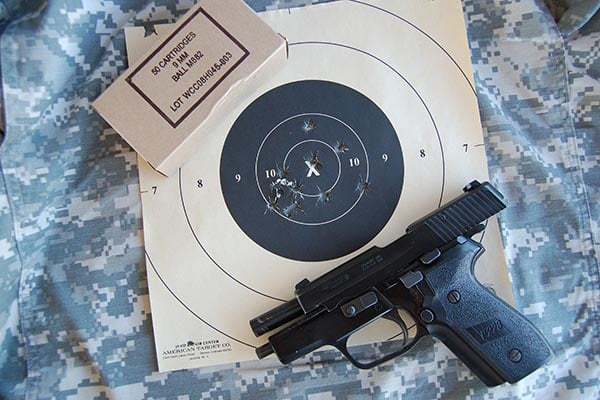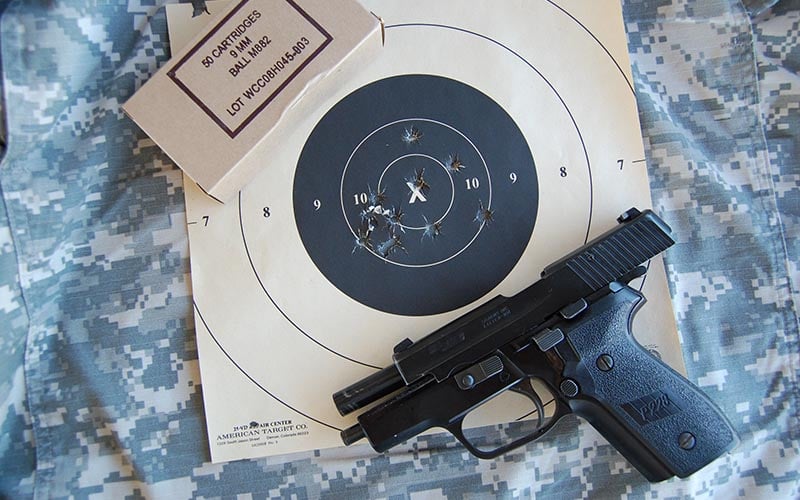
Last Updated on
Handguns are the most difficult small arm to learn to shoot well. Even if you don’t carry one by choice or profession, improvement with pistol shooting will have positive carry over to shooting other firearms well. It’s been noted for decades that successful pistol shots will normally shoot other firearms reasonably well with little additional training while the opposite isn’t always true. Here are a series of useful drills to improve your short gun shooting.
Dry Drills
Successful marksmen will tell you that shooting exercises done dry are among the most beneficial. In addition to being readily available and free (no range or ammunition needed), it’s important to develop and practice skills without the distraction of noise and recoil. The following drills are done without ammunition and can be done at home or on the range prior to live fire practice.

Hammer/Striker Downs
Your grip must remain solid and consistent as the the trigger is pressed and released. You can start to become aware of this during any type of snapping in (“firing” an aimed shot during dry practice) but this drill lets you isolate it. Clear the pistol and leave the hammer or striker down and forward. With double action pistols such as the Beretta 92/M9, leave the safety/decocker lever down as well. Assume your grip and, while aiming at a blank surface, stroke the trigger back and forth while maintaining sight alignment. Your index finger is working against the trigger’s return spring only, yielding a long but light trigger with the same pressure pressing and resetting. The goal is to train your hands to actuate the trigger, both pressing and resetting, without altering your grip or inducing misalignment. Strive for five complete press and releases in a row with no misalignment.
Full Snaps
When shooting multiple shots the trigger must be reset, prepped and pressed for each round. We can simulate that with full snaps. Clear the pistol, thumb cock the hammer or set the striker, ease the slide back a quarter inch, hold the trigger completely down and release the slide. Resume your grip and stance aiming on a blank wall while continuing to hold the trigger all the way back. Pretend you just fired a shot and reacquired the target after recoil. To shoot again, reset the trigger (release until it clicks), prep it (take the trigger slack out until the “wall” or sear resistance is felt), smoothly press until the hammer/striker falls, follow through, and release the trigger for the next shot. Keep your focus on maintaining good sight alignment, striving to maintain perfect alignment the entire time. This complete sequence is done for every shot during sustained or rapid fire, and any misalignment twitch of the sights you see in dry practice is an induced error that will show up in live shooting. Go for five in a row.
Eyes Off
The goal of any presentation is to get the gun from a condition of readiness to up and on target with minimum delay. Going through an instant or contact ready position is a good way to develop consistency. That consistency can be furthered by developing the ability to only move your hands and arms without moving anything else. As your un-timed dry presentation improves, either from a ready position or the holster, try the Eyes Off drill.
Start aimed in on a blank wall. Keeping your head fixed, move your pistol back to a ready position. Close your eyes and present the pistol into your standing shooting position. After your hands stop, the trigger is prepped for a shot, and it feels right, open your eyes. You should be seeing perfectly aligned sights with your aiming eye. If not, present again several times with your eyes open, noting how your hands and grip come together and concentrating on keeping your head fixed. After several of these, try it again with eyes closed. Lacking a comb of the stock to index against your face against as with a long gun, the most likely error is shifting your head and eye position. Your hands need to push the pistol straight out and your head needs to stay put in the same place behind where the aligned sights are going to appear during the presentation.
The goal is to develop proprioceptive sense of moving the firearm into a shooting position and in front of your aiming eye without visual confirmation. You’re proving you really know when it feels right by doing it with eyes closed and by feel alone. The benefits of successfully developing this are huge. You’re creating of sort of instant heads-up display that subconsciously puts the gun up on target where you want it. This is better and faster than point shooting because your eyes can confirm an alignment that you are able to obtain literally blindfolded as the gun is still moving to the target.
Live Drills
As useful as dry practice is, you still need to do it live. While it’s useful to practice without the distractions of noise and recoil, these elements must be dealt with to learn to shoot better. Plus – let’s face – it if guns didn’t make any noise we probably wouldn’t enjoy shooting them as much!
Skip Loading
Flinching is any unwanted movement or twitch that occurs during shooting that misaligns the firearm away from the intended point of impact. This is often referred to as “trigger jerk,” but the unwanted movement often manifests in more than the interface between the index finger and face of the trigger. Think of “jerking the trigger” as meaning ANY unintended movement (a jerk) anywhere in the body and anywhere against the firearm as the shot is being triggered.
The Ball and Dummy drill – an exercise where a non-firing dummy round is randomly inserted in the magazine or cylinder during shooting. This detects a flinching error but does nothing to fix it other than raise awareness. Shooting a pile of ammo with an occasional dummy round, flinching on the click and a coach’s admonition to “stop that” doesn’t help. You need to reprogram your subconscious and overcome your natural, normal reflex to push the gun away when it bucks suddenly and makes a loud noise near your face.

Dry practice is the first place to start. Eliminate extraneous movement while dry practicing when you know the firearm will make no noise. When learning any skill, training is most effective when most of the performed repetitions are done in a manner conducive to reinforcing good habits so eliminating the cause of bad habits – noise and recoil in this case. To beat a flinch, the shooter has to become inured to the noise and recoil. So simply shooting more ammunition in live practice without a plan reinforces a flinch. If a shooter has been shown to flinch by Ball and Dummy test, showing that is their actual reaction when the gun discharges, shooting more is just practicing to flinch more. As noted, only perfect practice makes perfect. We need to systematically program a different reflex.
Secure three magazines and a quantity of dummy rounds in a 4:1 ratio. That is, for every live round in one of these mags there are four dummy rounds. Mix the dummy and live rounds and charge the mags in a sequence. Slip the first cartridge (dummy or live) in magazine one, the second round into magazine two and rotate through until the mags are charged. Shuffle the mags, slip them into your ammo pouch or pocket, grab one at random and shoot slow fire. You want to have no idea the order each magazine was charged. Even if the dummy rounds look or feel different, the specific load sequence in each mag is confused, which is what you want. This is a good alternative when you train alone and don’t have a partner to mix the mags up for you.
Shoot a slow fire group. On each click, dry fire an additional three times before cycling the action. With two live rounds you’d mix in eight dummy rounds. In addition to the click of each randomly-loaded dummy, you dry fire three more times on it. That is 34 “shots” for each two live rounds fired. Refilling the magazines in this fashion two more times yields 102 total “shots” for your first six round group downrange.
Yes, you’re spending most of your range time dry firing. Before protesting, check your goal. You’ve already identified a flinch, a negative reaction to the gun going off, and simply shooting more ammo reinforces that reaction. Most of the rounds in the magazine are dummies but you don’t know which, keeping the shooting “real” with live ammo in the mix. Each click has you reinforcing the desired, correct habit by dry firing on a known dummy round. Most of the shooting is dry to reinforce the new reflex you are trying to program, which is to not react at all. Shoot a shot and if it’s a click reinforce what you want to happen three times. Shoot another shot and reinforce by triple again if it clicks. Continue doing the right thing most of the time long enough and that is the habit your brain will naturally run. As a bonus, this requires very little live ammo. A box of 50 live rounds provides 850 rounds of training value. How’s that for economy? It is good to have a partner watch you and/or to video yourself. Every time you click on a dummy round, note your response. You want to condition your subconscious to not anticipate or react to the recoil or noise.
More live drills coming tomorrow in Best Pistol Drills 2 – Live Fire.




Leave a Reply